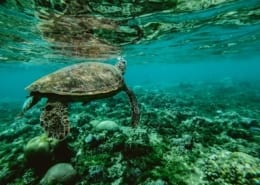Wildlife management is the positive manipulation of wild animal populations and their habitats for the benefit of both humans and creatures. This course suits those who work with animals – either in the wild, zoos, or conservation or captive breeding programs.
The Certificate of Wildlife Management is an online professional development program that explores a range of wildlife management practices from running parks and reserves, controlling pests, rehabilitating wildlife habitats and managing the harvests of wildlife.
In this wildlife management course, you will explore approaches to wildlife management, wildlife ecology, population dynamics, wildlife censuses and a variety of habitats from those in tropical and temperate climates to arctic, alpine and desert regions.
You will also learn about wildlife management techniques, law and administration, and undertake your own case study research project.
On completion of this course, you will have a broad-based introduction to the principles and practices of wildlife management common to a range of species around Australia and the world!
Course Structure
Unit 1 - Wildlife Management
Unit 1 – Introduction to Wildlife Management
- What is wildlife management
- Areas of focus and activities
- Approaches to wildlife management
- Preservation and conservation
- Purpose of wildlife management
- Reasons for managing wildlife
- Goals of wildlife management
- Decision making in wildlife management
- Who are the decision makers?
- Making the right decision
- Important concepts and considerations
- Range, distribution and habitat
- Needs of wildlife
- Good wildlife habitats
- Population limiting factors
- Carrying capacity
- Succession
- Habitat fragmentation
- Habitat diversity
- Biological control
- Integrated pest management
Unit 2 – Wildlife Ecology
- Ecology
- Types of ecology
- Population Ecology
- Community Ecology
- Ecosystem Ecology
- Interactions within a community
- Competition
- Predation
- Parasitism
- Commensalism
- Mutualism
- The food web
- The web of life
- Energy flow
- Imbalances
Unit 3 – Wildlife Habitats
- Classification of habitats
- Habitat types
- Location and characteristics of biomes and common wildlife
- Animal use of features within habitats
- Case study – nest boxes
- Logs, surface rocks and ground cover
- Creeks, wetlands and dams
- Case study – bird requirements and uses of habitat
- Requirements of birds in captivity
- Habitat features used by birds
- Trees
- Plants
- Changes to habitats
- Physical changes
- Biological changes
- Air pollution
- Water pollution
- Toxicants
- Water
- Siting water points
- Trees: more or less
- Deforestation and afforestation
Unit 4 – Population Dynamics and Pest Management
- Populations
- Birth or fecundity rate
- Death or mortality rate
- Population growth rate
- Control of pest or undesirable wildlife species
- The objectives of control
- The effects of control on a population
- Mortality manipulation
- Biological control
- Successful biological control examples
- Catastrophes in biological control
- General case studies
- Mosquitoes
- Grasshoppers (locusts)
- Birds and mammals
- Case study: feral animals in Australia
- Case study – total eradication of exotic species in New Zealand
Unit 5 – Carrying Capacity
- Pastoral setting
- Exponential population growth and population dynamics
- What is carrying capacity
- Fisheries – stock management
- Stock identity
- Stock assessment
- Stock biomass
- Stock management methods
Unit 6 – Wildlife Censuses
- Types of censuses
- Total counts
- Sampling
- Sampling accuracy vs precision, and bias errors
- Methods of wildlife censuses
- Aerial surveys
- Trapping
- Mark-recapture
- Transects
- Indirect methods
- Roadside and call counts
- Mapping
- Environmental DNA (eDNA)
- Taxon specific sampling methods
- Animal ethics
- Case study – the Calgary zoo’s swift fox survey
- Census objective
- Sampling plan and techniques
- Results
Unit 7 – Wildlife Management techniques
- Management of native wildlife
- Fire, vegetation management
- Predator control
- Habitat modification
- Habitat modelling
- Population monitoring
- Conservation breeding programs
- Case study – the North American giant salamander
- Translocation of threatened species
- Culling and harvesting
- Case studies culling
- Case studies culling and harvesting
- Fertility manipulation
- Genetic engineering
- Indirect methods
- Case studies cites and conservation (tigers and rhinoceros)
Unit 8 – Wildlife Management Law and Administration
- Policy and wildlife law
- International environmental law
- Making international laws
- Treaties
- International customary law
- Hard vs soft law
- Domestic (national) laws
- Evolving domestic law
- Sources of legislation
- Environmental ethics
- Enforcement of conservation laws
Unit 9 – Problem Based Learning (PBL) Project – Management of Endangered Fragmented Owl
Study Hours
Estimated duration 50 hours
Course Delivery and Start
Start anytime, self-paced and 100% online
Assessment
Assessment will be comprised of written exercises, including short-answer questions, reflective tasks, short reports and/or projects. There are no examinations or due dates for assessment. As a result, you can complete training in your own time and at your own pace with the assistance of unlimited tutor support.
Testimonials
I have thoroughly enjoyed this course, it has given a great understanding and knowledge to use in the future. I would definitely recommend this course to anyone interested in this subject.
M. Bremmell, Yarloop, WA | Certificate of Wildlife Management
Graduation
A Certificate of Attainment and Statement of Results will be issued upon successful completion of this course.
How to Enrol
Enrol Online: Click Enrol Now (Credit Card) or Enrol Now (Internet Banking/BPAY)
Enrol via Live Chat (Business Hours)
Enrol via Telephone 1300 76 2221 (Business Hours)
Enrol via Purchase Order/Tax Invoice
Enrolling Multiple Staff?
To enrol multiple staff, please complete the Employer Enrolment Form. We’ll be in touch within 60 minutes during business hours!
Payment Options
Visa, Mastercard, BPAY and Direct Deposit.
Course FAQs
Why Choose Australian Online Courses?
- Professional development that is widely recognised and respected;
- Improve your employment opportunities;
- Study online, anywhere via our elearning system;
- High-quality professional development programs written by industry experts;
- All course materials provided online – no textbooks to buy;
- Unlimited tutor support via email;
- We offer twelve (12) months’ access, with extensions available upon application (fees apply);
- Course may be tax deductible; see your tax advisor.
Are there any entry requirements or pre-requisites?
To study online with Australian Online Courses you will need a computer (desktop PC/laptop) running a current/updated operating system with reliable high-speed internet access. You will need to use the Google Chrome browser to access your course.
Are there any computer requirements?
To study online with Australian Online Courses you will need a computer (desktop PC/laptop) running a current/updated operating system with reliable high-speed internet access. You will need to use the Google Chrome browser to access your course.
When can I start this course?
You can start within 60 minutes during business hours when you enrol and pay in full with a credit card!
Credit card: Within 60 mins during business hours.
BPAY: Within 1-2 working days.
Internet Banking: Within 1-2 working days.
Cheque/Money Order: Upon receipt of mailed cheque.
How is this course delivered?
This course is delivered online via our easy-to-navigate Learning Management System (LMS), where you will discover interactive online learning/written content, resources and assessment.
Do I need to attend classes or undertake any work placements?
No. All courses are delivered online via our LMS and there are no work placement requirements in this course.
What support can I expect from Australian Online Courses?
Unlimited tutor support is available throughout your studies via email only during business hours Monday to Friday. Our Administrative team are available Monday to Friday via email, live chat and telephone.
I am an international student. Can I enrol into this course?
Yes! We accept enrolments from individuals both within Australia and internationally; location is no barrier to entry into our programs.
Career Pathways
Future growth
Strong
Unemployment
Low
Professional Development for:
- Zoo Workers
- Wildlife Conservation Workers










